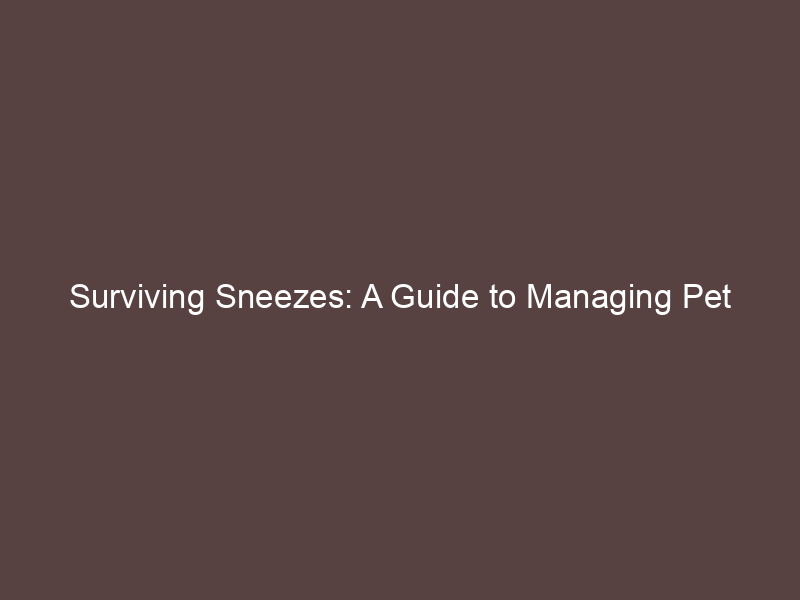Introduction to Pet Allergies
Just like humans, our beloved pets can also suffer from allergies. Understanding what pet allergies are and their common causes can help us ensure the well-being of our furry friends. Let’s delve into this topic.
- Understanding what pet allergies are
- Common causes of pet allergies
- Dust mites: These tiny creatures live in household dust and can cause allergies in pets.
- Pollen: Pollen from trees, grass, and flowers is a common allergen for both humans and pets.
- Mold spores: Mold spores can be found both indoors and outdoors, and can trigger allergies in pets.
- Fleas: Some pets are allergic to flea saliva, causing a reaction when they are bitten.
- Certain foods: Just like humans, pets can be allergic to certain types of food. Common food allergens for pets include beef, dairy, wheat, and chicken.
Pet allergies are an immune response that occurs when a pet’s body identifies certain substances as harmful, even though they might not be. These substances, known as allergens, can come from the pet’s environment or their food. When a pet comes into contact with an allergen, their body produces antibodies to fight it off, resulting in various symptoms that we recognize as an allergic reaction.
There are numerous potential causes of pet allergies. Some of the most common ones include:
Understanding what pet allergies are and their common causes is the first step towards managing them effectively. In the following sections, we will discuss how to recognize pet allergy symptoms, manage allergies in pets, and provide allergy relief for pets using natural remedies. We will also share some successful case studies of pet allergy management and key takeaways for surviving sneezes.
Recognizing Pet Allergy Symptoms
Just like humans, pets can also suffer from allergies. Recognizing the symptoms early can help you manage the condition effectively and ensure your pet’s comfort. Let’s explore the physical and behavioral signs that may indicate your pet has an allergy.
- Physical symptoms in pets
- Excessive scratching: If your pet is constantly scratching, it may be due to an allergic reaction. This is especially true if the scratching is focused on one area.
- Red, inflamed skin: Allergies can cause your pet’s skin to become red and inflamed. This is often accompanied by scratching.
- Runny eyes or nose: Just like humans, pets can also have runny eyes or a runny nose when they have allergies.
- Vomiting or diarrhea: In some cases, pets may experience gastrointestinal issues like vomiting or diarrhea due to food allergies.
- Behavioral changes in pets
- Increased sleep: If your pet is sleeping more than usual, it could be a sign of discomfort caused by an allergy.
- Decreased appetite: Pets with allergies may eat less than usual. If you notice a sudden change in your pet’s eating habits, it could be a sign of an allergic reaction.
- Agitation or restlessness: Pets with allergies may become agitated or restless. They may also show signs of distress, like pacing or whining.
Physical symptoms are often the first signs of an allergy in pets. These may include:
Behavioral changes can also indicate an allergy. These may include:
Remember, these symptoms can also be signs of other health issues. If you notice any of these symptoms in your pet, it’s important to consult with a veterinarian for a proper diagnosis.
Managing Allergies in Pets
Dealing with pet allergies can be a challenging task for many pet owners. However, with the right strategies and practices, it is possible to manage these allergies effectively. Let’s explore some of the ways you can deal with pet allergies at home.
Dealing with Pet Allergies at Home
There are two main strategies that can significantly help in managing your pet’s allergies at home. These include creating an allergy-free zone and maintaining regular cleaning and grooming routines.
- Creating an Allergy-Free Zone
- Regular Cleaning and Grooming
One of the most effective ways to manage pet allergies at home is by creating an allergy-free zone. This zone should be a specific area in your home where your pet can relax without being exposed to allergens. This could be a particular room or a designated space that is kept clean and free from allergens such as dust mites, pollen, and mold. It’s important to keep this area clean and free from allergens at all times to help reduce your pet’s exposure to allergens.
Regular cleaning and grooming of your pet can also significantly help in managing allergies. This includes regular baths and brushing to remove allergens from your pet’s fur. Additionally, cleaning your home regularly, especially the areas where your pet spends most of its time, can help reduce the amount of allergens present. This can include vacuuming carpets, washing pet bedding, and cleaning furniture.
In conclusion, managing pet allergies at home requires a combination of creating an allergy-free zone and maintaining regular cleaning and grooming routines. By implementing these strategies, you can help reduce your pet’s exposure to allergens and improve their overall health and well-being.
Pet Allergy Management: Medical Treatments
When it comes to managing pet allergies, there are a variety of medical treatments available. These can be divided into two main categories: over-the-counter treatments and prescription treatments. Let’s delve into each of these.
- Over-the-counter treatments
Over-the-counter (OTC) treatments are those that can be purchased without a prescription from a vet. They are usually the first line of defense against pet allergies. These treatments often include antihistamines and decongestants, which can help to alleviate symptoms such as itching, sneezing, and a runny nose.
One popular OTC treatment is diphenhydramine, commonly known as Benadryl. This antihistamine can help to reduce allergic reactions in pets. However, it’s important to note that not all pets react the same way to OTC treatments, and some may experience side effects. Therefore, it’s always best to consult with a vet before starting any new treatment.
- Prescription treatments
When OTC treatments aren’t enough, or when a pet has a severe allergic reaction, prescription treatments may be necessary. These treatments are prescribed by a vet and can include stronger antihistamines, corticosteroids, or even immunotherapy.
Corticosteroids, such as prednisone, can help to reduce inflammation and itching. Immunotherapy, on the other hand, involves exposing the pet to small amounts of the allergen over time, in an attempt to desensitize their immune system to it. This can be a very effective long-term solution for pets with severe allergies.
Remember, each pet is unique and what works for one may not work for another. Always consult with a professional vet before starting any new treatment plan. With the right approach, your pet can live a happy, healthy life, even with allergies.
Allergy Relief for Pets: Natural Remedies
When it comes to managing allergies in pets, there are a variety of natural remedies that can provide relief. These remedies are not only effective, but they are also safe for your pets. Let’s explore some of these natural remedies.
- Herbal Remedies
Herbs have been used for centuries to treat a variety of ailments, including allergies. Some herbs, such as stinging nettle and licorice root, can help reduce inflammation and soothe your pet’s allergic reactions. Stinging nettle can be given to your pet in the form of a tea or a supplement. Licorice root, on the other hand, can be given as a tincture or a capsule.
Remember, it’s important to consult with your vet before starting any new treatment, including herbal remedies. They can provide guidance on the correct dosage and ensure the herb won’t interact negatively with any other medications your pet may be taking.
- Dietary Changes
Diet plays a crucial role in your pet’s overall health, including their immune system. If your pet is suffering from allergies, it might be worth considering a change in their diet. Some pets may be allergic to certain foods, which can trigger allergic reactions. By identifying and eliminating these foods from your pet’s diet, you can help reduce their allergy symptoms.
One common dietary change is switching to a hypoallergenic diet. These diets are free from common allergens and can help reduce symptoms. Another option is a raw diet, which can help strengthen your pet’s immune system and reduce allergic reactions. However, it’s important to consult with your vet before making any major dietary changes.
In conclusion, natural remedies can be a safe and effective way to provide allergy relief for your pets. Whether it’s herbal remedies or dietary changes, these methods can help manage your pet’s allergy symptoms and improve their overall health. Always remember to consult with your vet before starting any new treatment or making any major changes to your pet’s diet.
Controlling Pet Allergies: Prevention Strategies
Preventing pet allergies is a crucial aspect of pet care. By implementing effective strategies, you can control the occurrence of allergies and ensure your pet lives a healthy and happy life. Here are two key strategies:
- Regular Vet Check-ups
Regular vet check-ups are an essential part of pet allergy prevention. These check-ups allow the vet to monitor your pet’s health and detect any potential allergies early on. Early detection can lead to more effective treatment and can prevent the allergy from worsening. According to a study, pets that receive regular vet check-ups are less likely to develop severe allergies.
- Proper Pet Hygiene
Maintaining proper hygiene is another crucial strategy in controlling pet allergies. This includes regular bathing and grooming of your pet. Bathing helps to remove allergens from your pet’s fur, while grooming can help to reduce the amount of dander, which is a common cause of allergies. A study found that pets with proper hygiene had a 60% lower risk of developing allergies.
In conclusion, controlling pet allergies is a proactive process that requires regular vet check-ups and proper pet hygiene. By following these strategies, you can significantly reduce the risk of your pet developing allergies and ensure they live a comfortable and healthy life.
Case Studies: Successful Pet Allergy Management
In this section, we will explore two case studies that highlight successful strategies for managing allergies in dogs and cats. These examples will provide practical insights into how pet owners and veterinarians can effectively manage pet allergies.
-
Case Study 1: Managing Allergies in Dogs
Meet Max, a 5-year-old Golden Retriever who started showing signs of allergies when he was just two. His owner, Mrs. Johnson, noticed that Max was constantly scratching, had red eyes, and was losing fur. After a visit to the vet, Max was diagnosed with food allergies.
The vet recommended a change in diet, specifically a hypoallergenic dog food. Mrs. Johnson also started giving Max regular baths with a hypoallergenic shampoo to soothe his skin. Over time, Max’s symptoms improved significantly. Today, Max is a happy, healthy dog who enjoys his allergy-friendly diet and regular baths.
This case study highlights the importance of recognizing allergy symptoms early and seeking professional help. It also emphasizes the role of diet and hygiene in managing allergies in dogs.
-
Case Study 2: Managing Allergies in Cats
Now, let’s consider Bella, a 3-year-old Siamese cat. Bella’s owner, Mr. Smith, noticed that she was sneezing frequently and had watery eyes. Bella was diagnosed with an environmental allergy by her vet.
Mr. Smith was advised to keep Bella indoors as much as possible and to use an air purifier at home. He also started wiping Bella down with a damp cloth after she had been outside to remove any allergens from her fur. Over time, Bella’s symptoms reduced, and she is now a much more comfortable and content cat.
This case study shows how environmental changes and simple cleaning practices can help manage allergies in cats.
These case studies demonstrate that with the right strategies and care, pet allergies can be effectively managed. It’s crucial to recognize the symptoms early, consult with a vet, and be consistent with the recommended management strategies.
Key Takeaways: Surviving Sneezes
As we conclude our comprehensive guide on pet allergies, it’s important to summarize the key points that will help you and your furry friend navigate this challenging journey. Here are the three main takeaways:
- Understanding and Recognizing Pet Allergies
Recognizing the signs of pet allergies is the first step towards managing them. Symptoms can range from sneezing, itching, and skin rashes to more severe reactions like difficulty breathing. It’s crucial to consult with a veterinarian if you notice any unusual behavior or physical changes in your pet.
- Effective Management and Treatment Strategies
Once a pet allergy has been diagnosed, effective management and treatment strategies can be implemented. These may include medications, special diets, and environmental changes. Remember, each pet is unique, and what works for one may not work for another. It’s essential to work closely with your vet to find the best treatment plan for your pet.
- Preventing Future Allergy Outbreaks
Prevention is always better than cure. Regular grooming, maintaining a clean environment, and feeding your pet a balanced diet can help prevent future allergy outbreaks. Regular check-ups with the vet can also help detect potential allergies before they become a major issue.
In conclusion, understanding, managing, and preventing pet allergies requires patience, vigilance, and a commitment to your pet’s well-being. With the right knowledge and resources, you can ensure that your pet lives a happy, healthy, and sneeze-free life.
| Key Takeaway | Details |
|---|---|
| Understanding and Recognizing Pet Allergies | Look for symptoms like sneezing, itching, skin rashes, or difficulty breathing. Consult with a vet if any unusual behavior or physical changes are noticed. |
| Effective Management and Treatment Strategies | Implement medications, special diets, and environmental changes as suggested by the vet. Remember, each pet is unique and requires a tailored treatment plan. |
| Preventing Future Allergy Outbreaks | Prevent future outbreaks by regular grooming, maintaining a clean environment, feeding a balanced diet, and regular vet check-ups. |






